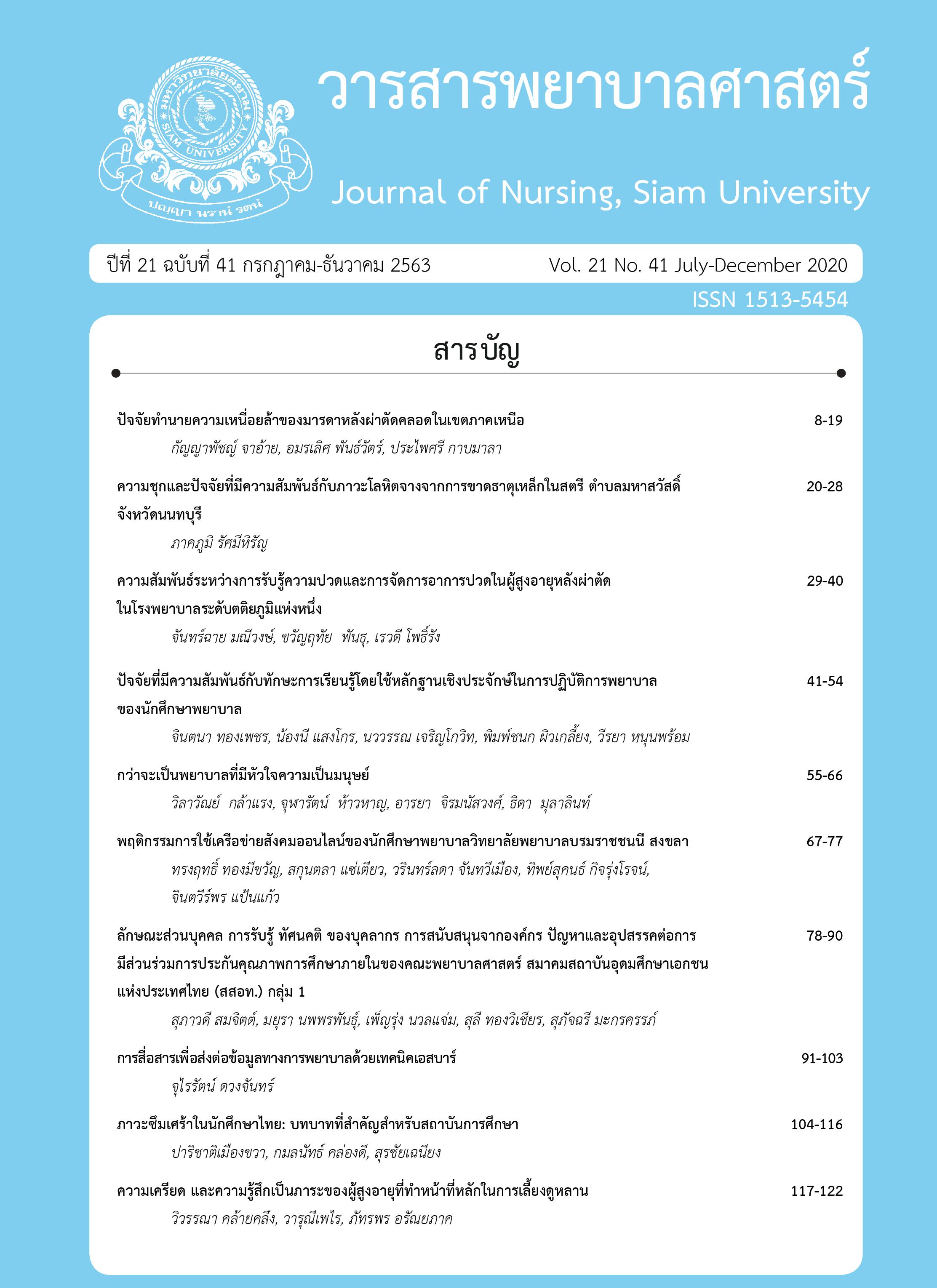การสื่อสารเพื่อส่งต่อข้อมูลทางการพยาบาลด้วยเทคนิคเอสบาร์
DOI:
https://doi.org/10.14456/jnsu.v21i41.242259คำสำคัญ:
การสื่อสาร, การส่งต่อข้อมูลทางการพยาบาล, เอสบาร์บทคัดย่อ
การสื่อสารเพื่อส่งต่อข้อมูลทางการพยาบาลเป็นกระบวนการส่งข้อมูลทางคลินิกของผู้ป่วยจากพยาบาลหรือทีมพยาบาลที่ดูแลผู้ป่วยมาก่อนหน้านี้ ส่งต่อไปยังพยาบาลอีกคนหรืออีกทีมพยาบาลรวมทั้งเป็นการถ่ายโอนและการยอมรับความรับผิดชอบในการดูแลผู้ป่วยผ่านการสื่อสารที่มีประสิทธิภาพ การส่งต่อข้อมูลที่มีประสิทธิภาพในทีมสุขภาพเป็นปัจจัยสำคัญสำหรับความต่อเนื่องและความปลอดภัย ลดเหตุการณ์ไม่พึงประสงค์ที่เกิดขึ้นกับผู้ป่วย
บทความวิชาการนี้นำเสนอความสำคัญของทักษะการสื่อสารที่มีประสิทธิภาพ ปัญหาและอุปสรรคในการสื่อสาร และกลยุทธ์สำหรับการส่งต่อข้อมูลทางการพยาบาลที่มีประสิทธิภาพ ด้วยการใช้เทคนิคเอสบาร์ซึ่งเป็นเครื่องมือสื่อสารมาตรฐานที่มีประสิทธิภาพ ลดเหตุการณ์ไม่พึงประสงค์และส่งเสริมความปลอดภัยของผู้ป่วย ซึ่งประกอบด้วยข้อมูลสถานการณ์ ภูมิหลังผู้ป่วย การประเมินสภาพและคำแนะนำ นอกจากนี้ ได้เสนอแนะแนวทางในการนำเทคนิคเอสบาร์ไปประยุกต์ใช้ในการพัฒนาการสื่อสารเพื่อส่งต่อข้อมูลที่เป็นมาตรฐานในหน่วยบริการพยาบาล เพื่อผลลัพธ์ด้านสุขภาพและความพึงพอใจของผู้ป่วย รวมทั้งการศึกษาวิจัยเพื่อประเมินผลลัพธ์ทั้งในเชิงระบบ ต่อผู้ให้บริการและผู้รับบริการ
เอกสารอ้างอิง
จุไรรัตน์ ดวงจันทร์, บุญทิพย์ สิริธรังศรี, ทรงศรี สรณสถาพร, และวันเพ็ญ ภิญโญภาสกุล. (2562). การพัฒนาสมรรถนะการสื่อสารเพื่อส่งต่อข้อมูลทางการพยาบาล โดยใช้บทเรียนออนไลน์สำหรับนักศึกษาพยาบาล. วารสารพยาบาลสงขลานครินทร์, 39(2), 98-112.
ประภัสสร มนต์อ่อน. (2554). ประสิทธิผลของการใช้รูปแบบการรายงานเปลี่ยนเวรของพยาบาลวิชาชีพโรงพยาบาลพุทธโสธร (วิทยานิพนธ์ ปริญญาพยาบาลศาสตรมหาบัณฑิต). มหาวิทยาลัยบูรพา, ชลบุรี.
พนมพร กีรติตานนท์. (2559). ผลการใช้รูปแบบการรับส่งเวรข้างเตียงต่อการรับรู้คุณค่าและจรรยาบรรณวิชาชีพพยาบาล. วารสารศูนย์การศึกษาแพทยศาสตร์คลินิก โรงพยาบาลพระปกเกล้า, 33(2), 117-128.
พรพิมล ศรีสำราญ, กันย์สินี วิเศษสิงห์, กฤตยา ตันติวรสกุล. (2561). การพัฒนารูปแบบการรายงานเปลี่ยนเวรของพยาบาลวิชาชีพ โรงพยาบาลบ้านโป่ง. วารสารแพทย์เขต 4-5, 37(3), 238-250.
พรพิไล นิยมถิ่น, อารี ชีวเกษมสุข, และวันเพ็ญ ภิญโญภาสกุล. (2560). การพัฒนารูปแบบการสื่อสารในการส่งต่อผู้ป่วยฉุกเฉินโรงพยาบาลสมเด็จพระยุพราชด่านซ้าย จังหวัดเลย. วารสารการพยาบาลและการดูแลสุขภาพ, 35(1), 46-54.
รัชนี ศิริวัฒน์, นิตยา โรจน์ทินกร, สุรัตน์ คร่าสุข, จิราพร พอกพูนทรัพย์, และจันทร์ทิรา เจียรณัย. (2562) การพัฒนารูปแบบการสื่อสารทางการพยาบาลแบบไร้รอยต่อโดยใช้เทคนิค SBAR ในระยะเปลี่ยนผ่านการดูแล งานผู้ป่วยอุบัติเหตุและฉุกเฉิน โรงพยาบาลมหาราชนครราชสีมา. วารสารการพยาบาลและการดูแลสุขภาพ, 37(1),60-69.
รัตนา จารุวรรโณ, จารุภา วงศ์ช่างหล่อ, และถนิมพร พงศานานุรักษ์. (2557). ผลของการสอนการรับส่งเวรโดยใช้เทคนิค SBAR ต่อความรู้ ทัศนคติและทักษะในการรับส่งเวรของนักศึกษาพยาบาล. วารสารพยาบาลทหารบก, 15(3), 390-397.
ศรีลาวัลย์ สัจจะสกุลชัย และอารี ชีวเกษมสุข. (2559). ผลการใช้รูปแบบรายงานการส่งเวรด้วยกระบวนการพยาบาลและการบริหารความเสี่ยงต่อความผิดพลาดในการสื่อสาร หอผู้ป่วยทารกแรกเกิดมีปัญหา โรงพยาบาลตำรวจ. วารสารพยาบาลตำรวจ, 8(2), 91-106.
Arora, V., & Johnson, J. (2006). A model for building a standardized hand-off protocol. The Joint Commission Journal on Quality and Patient Safety, 32(11), 646-655.
Bonds, R. L. (2018). SBAR tool implementation to advance communication, teamwork, and the perception of patient safety culture. Creative Nursing, 24(2), 116-123.
Bramhall, E. (2014). Effective communication skills in nursing practice. Nursing Standard, 29(14), 53-59.
Collins, G. (2014). Using simulation to develop handover skills. Nursing Times, 110(8), 12-14.
Cornell, P., Gervis, M., Yates, L., & Vardaman, J. M. (2013). Improving shift report focus and consistency with the situation, background, assessment, recommendation protocol. The Journal of Nursing Administration, 3(7-8), 422-428.
Cornell, P., Gervis, M., Yates, L., & Vardaman, J. M. (2014). Impact of SBAR on nurse shift reports and staff rounding. MEDSURG Nursing, 23(5), 334-342.
Cudjoe, K. G. (2016). Add identity to SBAR. Nursing made Incredibly Easy, 14(1), 1-6.
Foronda, C., Gattamorta, K., Snowden, K., & Baumanc, E.B. (2014). Use of virtual clinical simulation to improve communication skills of baccalaureate nursing students: A pilot study. Nurse Education Today, 34, e53–e57.
Galatzan, B. J., & Carrington, J. M. (2018). Exploring the state of the science of the nursing hand-off communication. Computers Informatics Nursing, 36(10), 484-493.
Gore, A., Leasure, A. R., Caruthers, C., & Miller, B. (2015). Integrating hand-off communication into undergraduate nursing clinical courses. Journal of Nursing Education and practice, 5(4), 70-76.
Hsu, L., Huang, Y., & Hsieh, S. (2014). The effects of scenario-based communication training on nurses’ communication competence and self-efficacy and myocardial infarction knowledge. Patient Education and Counseling, 95, 356–364.
Kostiuk, S. (2015). Can learning the ISBARR framework help to address nursing students’ perceived anxiety and confidence levels associated with handover reports?. Journal of Nursing Education, 54(10), 583-587.
McClelland, D. C. (1973). Testing for competency rather than for intelligence. American Psychologist, 28(1), 1-14.
McCroskey. J. C. (1984). Communication competence: The elusive construct. In R. N. Bostrom (Ed.), Competence in communication: A multidisciplinary approach (pp. 259-268). Beverly Hills, CA: Sage.
Mitchell, A., Gudeczauskas, K., Therrien, A., & Zauher, A. (2018). Bedside reporting is a key to communication. Journal of Healthcare Communications, 3(1), 1-3.
Müller, M., Jürgens, J., Redaèlli, M., Klingberg, K., Hautz, W. E., & Stock, S. (2018). Impact of the communication and patient hand-off tool SBAR on patient safety: A systematic review. BMJ Open, 8(8), e022202. doiI:10.1136/bmjopen-2018-022202
Nagammal, S., Nashwan, A.J., Nair, S.L.K., & Susmitha, A. (2017). Nurses’ perceptions regarding using the SBAR tool for hand-off communication in a tertiary cancer center in Qatar. Journal of Nursing Education & Practice, 7(4), 103-110.
Palma, J. P., Sharek, P. J., & Longhurst, C. A. (2011). Impact of electronic medical record integration of a handoff tool on signout in a newborn intensive care unit. Journal of Perinatology, 31(5), 311–317
Riesenberg, L. A., Leitzsch, J., Cunningham, J. M. (2010). Nursing handoffs: A systematic review of the literature. The American journal of nursing, 110(4), 24-34.
Rose, M., & Newman, S. (2016). Factors influencing patient safety during postoperative handover. American Association of Nurse Anesthetists Journal, 84(5), 329-338.
Saied, H., James, J., Singh, E.J., & Humaied, L.A. (2016). Clinical evaluation of baccalaureate nursing students using SBAR format: Faculty versus self evaluation. Journal of Education and Practice, 7(11), 9-13.
Seada, A. M., & Bayoumy, S. A. (2017). Effectiveness of handoff educational program on nurses interns’ knowledge, and communication competence, American Journal of Nursing Science, 6(6), 467-477
Shahid, S., & Thomas, S. (2018). Situation, background, assessment, recommendation (SBAR) communication tool for handoff in health care – A narrative review. Safety in Health, 4(7), 2-9.
Staggers, N., Clark, L., Blaz, J., & Kapsandoy, S. (2012). Nurses' information management and use of electronic tools during acute care handoffs. Western Journal of Nursing Research, 34(2), 153–173.
Stewart, K. R., & Hand, K. A. (2017). SBAR, communication, and patient safety: An integrated literature review. MEDSURG Nursing, 26(5), 297-304.
Stojan, J., Mullan, P., Fitzgerald, J., Lypson, M., Christner, J., Haftel, H., Schiller, J. (2016). Handover education improves skill and confidence. The Clinical Teacher, 13(6):422-426.
The Joint Commission Center for Transforming Healthcare. (2014). Improving transitions of care: Hand-off communications. Oakbrook Terrace, Illinois: The Joint Commission.
The Joint Commission. (2017). Inadequate hand-off communication. Sentinel Event Alert Newsletter, September 12(58), 1-6.
Vertino, K. (2014). Effective interpersonal communication: A practical guide to improve your life. The Online Journal of Issues in Nursing, 19(3), e1. doi: 10.3912/OJIN.
Wang, W., Liang, Z., Blazeck, A., & Greene, B. (2015). Improving Chinese nursing students' communication skills by utilizing video-stimulated recall and role-play case scenarios to introduce them to the SBAR technique. Nurse Education Today, 35(7), 881–887.
WHO Collaborating Centre for Patient Safety Solution. (2007). Communication during patient hand-overs: Patient safety solutions. Joint Commission Journal on Quality and Patient Safety, 33(7), 439-442.
Yu, M., & Kang, K. (2017). Effectiveness of a role-play simulation program involving the SBAR technique: A quasi-experimental study. Nurse Education Today, 53, 41–47.
ดาวน์โหลด
เผยแพร่แล้ว
รูปแบบการอ้างอิง
ฉบับ
ประเภทบทความ
สัญญาอนุญาต
เนื้อหาและข้อมูลที่เผยแพร่ในวารสารพยาบาลศาสตร์ มหาวิทยาลัยสยามถือเป็นข้อคิดเห็นและความรับผิดชอบของผู้นิพนธ์บทความโดยตรง
บทความ เนื้อหา ข้อมูล รูปภาพ ฯลฯ ที่ได้รับการเผยแพร่ในวารสารพยาบาลศาสตร์ มหาวิทยาลัยสยาม ถือเป็นลิขสิทธิ์ของวารสารพยาบาลศาสตร์ มหาวิทยาลัยสยาม หากบุคคลหรือหน่วยงานใดต้องการนำทั้งหมดหรือส่วนหนึ่งส่วนใดไปเผยแพร่หรือเพื่อกระทำการใด ๆ จะต้องอ้างอิงวารสารพยาบาลศาสตร์ มหาวิทยาลัยสยามทุกครั้ง



